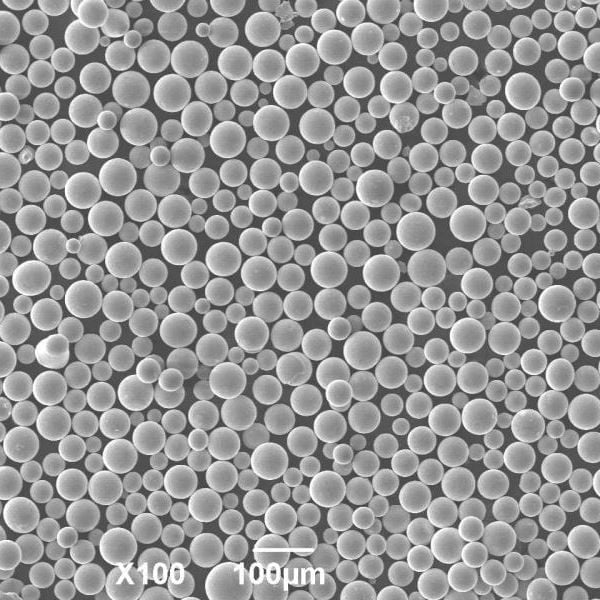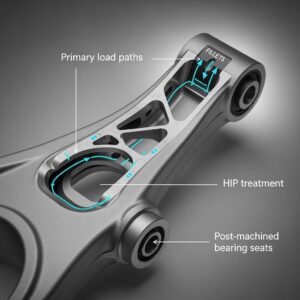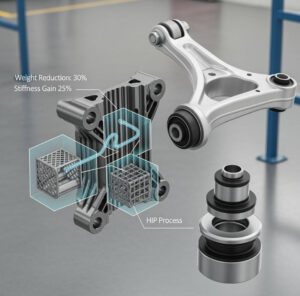Gas Atomized Powder: A Comprehensive Guide
Table of Contents
Gas atomized powder is a type of metal powder produced through gas atomization, a process where molten metal is broken up into droplets and rapidly cooled by a high pressure gas stream. This method produces a very fine, spherical powder ideal for applications like metal injection molding, additive manufacturing, and surface coating processes.

How Gas Atomized Powder is Made
The gas atomization process starts by melting the desired metal in an induction furnace. Once the metal reaches the optimum temperature, it is poured in a thin stream into the atomization chamber. High pressure inert gas (usually nitrogen or argon) is forced through specialized nozzles, creating strong gas currents that break up the molten metal stream into very fine droplets.
As the droplets fall through the chamber, they rapidly solidify into powder particles due to the high surface area to volume ratio. The gas also prevents the particles from agglomerating. The powder falls through the chamber onto a collection screen where it is sifted to achieve the desired particle size distribution.
Key steps in gas atomized powder production
| Step | Description |
|---|---|
| Melting | Metal is melted in an induction furnace |
| Pouring | Molten metal is poured into the atomization chamber |
| Atomization | High pressure gas breaks up metal stream into fine droplets |
| Solidification | Droplets rapidly cool into solid powder particles |
| Collection | Powder is collected at the bottom of the chamber |
| Screening | Powder is sieved to achieve target particle size distribution |
Benefits of Gas Atomized Powder
Some key advantages of gas atomized powder include:
- Spherical morphology – The droplets solidify into very spherical particles ideal for sintering and melting.
- Fine particle size – Particle sizes ranging from 10 – 150 microns can be achieved. Much finer than other methods.
- Narrow distribution – The particle size distribution is very narrow, improving sinterability.
- High purity – The inert gas prevents oxidation and minimizes contamination.
- Good flowability – Spherical shape improves powder flow characteristics.
- Wide applicability – Most metals and alloys can be gas atomized into powder.
These properties make gas atomized powders well suited for metal injection molding, additive manufacturing, and advanced sintering applications. The high purity and spherical morphology result in excellent densification behavior.
Metals and Alloys Used for Gas Atomization
| Material | Examples |
|---|---|
| Stainless steels | Austenitic, ferritic, duplex, and martensitic stainless steels like 316L, 17-4PH, 420 |
| Tool steels | H13, M2 |
| Cobalt alloys | CoCrMo |
| Nickel alloys | Inconel, Rene |
| Titanium alloys | Ti-6Al-4V |
| Refractory metals | Tungsten, molybdenum, tantalum |
| Copper alloys | Brass, bronze, copper |
| Aluminum alloys | 6061 aluminum |
| Precious metals | Silver, gold, platinum group |
- Stainless steels – Austenitic, ferritic, duplex, and martensitic stainless steels are commonly gas atomized. Grades like 316L, 17-4PH, and 420 are popular.
- Tool steels – Tool steels like H13 and M2 can be atomized. Used for molding tooling components.
- Cobalt alloys – Biocompatible cobalt alloys for dental and medical uses like CoCrMo.
- Nickel alloys – Superalloys like Inconel and Rene alloys are gas atomized for turbine components.
- Titanium alloys – Ti-6Al-4V alloy powder for aerospace components and implants.
- Refractory metals – Tungsten, molybdenum, tantalum commonly atomized.
- Copper alloys – Brass, bronze, and copper atomized for electronic/electrical uses.
- Aluminum alloys – Aluminum 6061 commonly atomized for automotive and aerospace.
- Precious metals – Silver, gold, platinum group metals atomized for jewelry uses.
Nearly any alloy that melts without decomposing can be gas atomized if parameters like melt superheat and gas pressure are optimized.
Related Products:
Typical Particle Size Distribution
Gas atomized powders are characterized by their particle size distribution. This gives an indication of the average size and range of powder sizes produced. A typical particle size distribution may look like:
| Particle Size (microns) | Percentage |
|---|---|
| 10-25 | 10% |
| 25-45 | 40% |
| 45-75 | 30% |
| 75-105 | 15% |
| 105-150 | 5% |
- Majority of particles are in the 25-75 micron range
- Minimum particle size around 10 microns
- Maximum around 150 microns
- Narrow distribution with standard deviation around 30 microns
The particle size range and distribution influences the powder properties and application suitability. Finer distributions are used for micro molding while coarser sizes for kinetic spraying.
How to Choose Suitable Gas Atomized Powder
Here are some recommendations on selecting the right gas atomized powder for your application:
- Match the alloy composition to your end use requirements like corrosion resistance or high temperature strength.
- Consider particle size based on intended use. Finer powders (~15 μm) for micro MIM, coarser (~60 μm) for cold spraying.
- Spherical morphology above 90% ensures maximum density with sintering or melting.
- Narrow particle size distribution improves flow and enhances green density.
- Higher purity and lower oxygen content powder for improved mechanical properties.
- Steels typically atomized in argon, reactive alloys like titaniums in nitrogen atmosphere.
- Choose reputable powder suppliers that can provide complete analysis reports.
- Consider atomization process parameters used by supplier to ensure suitable powder characteristics.
- Request samples to run evaluations and tests before purchasing large quantities.
How Gas Atomized Powder is Used
| Application | Uses |
|---|---|
| Metal Injection Molding | Fine powders for micro MIM, high powder loading, spherical morphology for strength |
| Additive Manufacturing | Spherical morphology for SLS/DMLS, fine powders for binder jetting |
| Thermal Spray | Gas atomized feedstock for cold spray, fine distribution for solution precursor spraying |
| Surface Engineering | Spherical powder for kinetic metallization, powder coating |
Metal Injection Molding (MIM)
- Finer gas atomized powders for micro MIM of small, complex parts.
- Excellent flowability allows high powder loading and green density.
- Spherical morphology gives superior sintered strength and density.
Additive Manufacturing
- Ideal spherical morphology for powder bed fusion processes like selective laser sintering (SLS) and direct metal laser sintering (DMLS).
- Inert gas atomization improves powder reuse due to low oxygen content.
- Fine powder used in binder jetting and inkjet metal printing processes.
Thermal Spray
- Gas atomized feedstock preferred for high velocity spray processes like cold spray.
- Dense coatings from deformation of ductile, spherical powder particles on impact.
- Finer powder distributions for suspension and solution precursor spraying.
Surface Engineering
- Spherical powders allow smooth surface finish in kinetic metallization processes.
- Excellent flowability suits powder coating processes for corrosion and wear protection.
- Fine controlled sizes for surface texturing and grading applications.
Challenges Associated with Gas Atomized Powder
While having many benefits, gas atomized powder also comes with some challenges:
- High upfront capital investment for gas atomization equipment.
- Requires technical expertise to operate and optimize atomization process.
- Can be prone to oxidation if handling and storage not proper.
- Spherical powder morphology makes it harder to achieve high green density in pressing.
- Fine powders prone to dusting issues during handling and processing.
- Costly compared to water atomized and pre-alloyed powders.
- Contamination risks from improper gas atomization atmosphere.
- Variable quality between different powder suppliers and grades.
Proper steps must be taken to minimize these issues to gain the full advantages of gas atomized powder.
Recent Advances in Gas Atomized Powder Technology
Some newer developments in gas atomized powder production include:
- Multi-nozzle atomization for higher powder yields and faster production.
- Close-coupled atomization to minimize melt oxidation.
- Smooth powder production from ultrasonic gas atomization.
- Novel gas atomizing gases like helium for finer atomization.
- Gas conditioning systems to recycle and purify atomizing gas.
- Advanced screening techniques for tighter particle size distributions.
- Specialized gas atomizer designs for reactive alloys like magnesium and aluminum.
- Automated powder handling systems to minimize contamination.
- High pressure micro-nozzle atomization for submicron powder sizes.
- Integrated powder production, handling, and quality control systems.
Frequently Asked Questions
Here are some common FAQs about gas atomized powders:
Q: What is the major advantage of gas atomized powder?
A: The very spherical particle morphology produced by gas atomization is the biggest advantage. This leads to excellent flow and compaction properties.
Q: What industries use gas atomized powder the most?
A: The automotive and aerospace industries are major consumers of gas atomized powder for metal injection molding and additive manufacturing.
Q: What is the typical gas used for atomization of steels?
A: Most steels are gas atomized using either nitrogen or argon gas due to their inert properties.
Q: How small can gas atomized powder particles be made?
A: Using specialized micro-nozzle atomizers, gas atomized powders with particle sizes below 1 micron are possible. Normal range is 10-150 microns.
Q: Can gas atomized powders be alloyed?
A: Yes, pre-alloyed gas atomized powders are produced by first melting and mixing alloys before atomizing.
Q: What causes satellites in gas atomized powder?
A: Satellites are caused by incomplete breakup of molten metal into fine droplets. Higher gas pressure reduces satellites.
Q: Does gas atomized powder have good sintering properties?
A: The spherical morphology and high purity of gas atomized powder lead to excellent sintering behavior. Over 98% density can be achieved.
Q: How are reactive metals like titanium and magnesium gas atomized?
A: Reactive metals are atomized using an inert gas containment system that prevents exposure to oxygen and nitrogen.
This covers the key aspects of gas atomized powder production, properties, applications, and technology. Let me know if you need any clarification or have additional questions!
Frequently Asked Questions (Advanced)
1) What process parameters most affect sphericity and satellite formation in Gas Atomized Powder?
- Key levers: gas-to-metal ratio (GMR), nozzle design (close-coupled vs free-fall), melt superheat, gas type (Ar/N2/He), and chamber pressure. Higher GMR, optimized close-coupled nozzles, and sufficient superheat reduce satellites and increase sphericity.
2) How do argon, nitrogen, and helium compare as atomizing gases?
- Argon: inert, broadly used, balanced cost/performance. Nitrogen: lower cost but can nitride/react with some alloys (e.g., Ti, high-Mn steels). Helium: enables finer droplets and faster quench rates but is costly; often used in blends (Ar/He) for very fine PSD.
3) What oxygen specifications are typical for AM-grade gas atomized powders?
- Common targets: stainless steels 0.07–0.12 wt% O, Ni-base superalloys 0.04–0.10 wt% O, Ti alloys ≤ 0.12 wt% O (ELI tighter). Actual limits depend on alloy and application; lower O reduces lack-of-fusion defects and improves ductility.
4) How should Gas Atomized Powder be stored to preserve quality?
- Use sealed, inert-filled containers; maintain RH < 30%; avoid temperature cycling to prevent condensation; ground all handling equipment; and log open/close events in a digital powder passport per ISO/ASTM 52907.
5) What inline/atline tests best control lot-to-lot consistency?
- Laser diffraction PSD (ASTM E2491), Hall/Carney flow (B213/B821), apparent/tap density (B212/B527), O/N/H by inert gas fusion, SEM for satellites/sphericity, and ICP-OES for residuals. Trending Hausner ratio (≤1.25) is a fast indicator of flow consistency.
2025 Industry Trends
- Digital powder passports: Broad adoption linking powder genealogy, PSD, interstitials, and reuse cycles to part serial numbers in AM and MIM.
- Sustainability in atomization: Argon recirculation, heat recovery, and verified recycled feedstock content (40–60%) become standard in RFQs.
- Close-coupled and ultrasonic atomization: Wider deployment to reduce satellites and tighten PSD for micro-MIM and fine LPBF.
- Inline sensing: Real-time O2/H2O and optical/acoustic PSD monitoring at atomizer outlets reduce scrap and rework.
- Safety by design: DHA-led facility upgrades, improved LEV testing, and intrinsically safe handling for combustible metal powders per NFPA 484.
2025 Snapshot: Gas Atomized Powder KPIs
| KPI | 2023 Baseline | 2025 Estimate | Relevance |
|---|---|---|---|
| Oxygen in AM-grade stainless (wt%) | 0.10–0.18 | 0.07–0.12 | Better LPBF density/ductility |
| Satellite fraction (%) | 10–20 | 5–12 | Improved flowability/surface finish |
| Share of lots with digital passports (%) | 20–30 | 45–65 | Traceability for regulated sectors |
| Argon recirculation energy savings (%) | 0–10 | 10–25 | Lower OPEX and CO2e |
| Inline PSD monitoring adoption (%) | Pilot | 25–40 | Tighter lot control |
| Typical LPBF relative density with tuned sets (%) | 99.4–99.8 | 99.7–99.95 | Part reliability gains |
Selected references:
- ISO/ASTM 52907 (metal powder quality for AM), ISO/ASTM 52941 — https://www.iso.org
- ASTM B212/B213/B214/B527, E2491 — https://www.astm.org
- ASM Handbook Vol. 7 (Powder Metallurgy), Vol. 24 (Additive Manufacturing) — https://www.asminternational.org
- NFPA 484 (Combustible Metals) — https://www.nfpa.org
Latest Research Cases
Case Study 1: Close-Coupled Argon Atomization for Fine 316L AM Powder (2025)
- Background: An AM service bureau reported variable surface finish and higher defect rates on thin-walled 316L builds.
- Solution: Switched to close-coupled argon atomization with controlled superheat and inline O2 monitoring; implemented post-atomization plasma spheroidization and automated classification for 15–45 µm cut.
- Results: Satellite fraction −38%; oxygen reduced from 0.13 to 0.09 wt%; average LPBF density 99.93%; Ra on vertical walls improved by 18%; scrap −22% over 4,000 parts.
Case Study 2: Ar/He Blend Atomization for Micro-MIM Cobalt Alloy Powders (2024)
- Background: A medical components maker needed sub-20 µm spherical CoCrMo powder for micro-MIM with tight shrinkage control.
- Solution: Used Ar/He blended gas to increase quench rate; optimized cyclone collection to retain fines; enhanced deoxidation/anneal.
- Results: D50 shifted from 24 µm to 17 µm with maintained sphericity; sintered density +1.1% absolute; dimensional variability (3σ) −27%; yield +12%.
Expert Opinions
- Prof. Randall M. German, Powder Metallurgy Expert
- Viewpoint: “Gas-to-metal ratio and melt superheat remain the primary knobs for PSD control—pair them with inline sensors to make atomization predictable rather than empirical.”
- Dr. Christina Noguez, Senior Scientist, Fraunhofer IFAM
- Viewpoint: “Surface oxide and moisture layers dominate downstream performance in AM and Binder Jet—oxygen management from atomizer to build plate is non-negotiable.”
- James Sears, VP Technology, Carpenter Additive
- Viewpoint: “Digital material passports linking powder lots to in-process telemetry and HIP cycles are rapidly becoming a qualification requirement.”
Practical Tools/Resources
- Standards and QA
- ISO/ASTM 52907; ASTM B212/B213/B214/B527; ASTM E2491 for PSD — https://www.iso.org | https://www.astm.org
- Safety and compliance
- NFPA 484 combustible metals guidance; OSHA combustible dust resources — https://www.nfpa.org | https://www.osha.gov
- Characterization and data
- NIST AM Bench datasets; SEM image analysis for sphericity/satellites — https://www.nist.gov
- Process and simulation
- Atomization modeling (CFD) and AM distortion tools: Ansys Fluent, Ansys Additive, Simufact Additive
- Supply chain and sustainability
- Environmental Product Declarations (EPDs) and recycled content verification programs for metal powders — https://www.environdec.com
Last updated: 2025-10-17
Changelog: Added advanced FAQ on gases, oxygen specs, storage, and inline QC; 2025 trends with KPI table; two recent case studies (close-coupled 316L; Ar/He micro‑MIM CoCrMo); expert viewpoints; and curated tools/resources with authoritative links
Next review date & triggers: 2026-04-30 or earlier if ISO/ASTM standards update, inline monitoring adoption exceeds 50%, or validated datasets show ≥25% defect reduction via new atomization/nozzle technologies
Share On
MET3DP Technology Co., LTD is a leading provider of additive manufacturing solutions headquartered in Qingdao, China. Our company specializes in 3D printing equipment and high-performance metal powders for industrial applications.
Inquiry to get best price and customized Solution for your business!
Related Articles

Metal 3D Printing for U.S. Automotive Lightweight Structural Brackets and Suspension Components
Read More »About Met3DP
Recent Update
Our Product
CONTACT US
Any questions? Send us message now! We’ll serve your request with a whole team after receiving your message.









